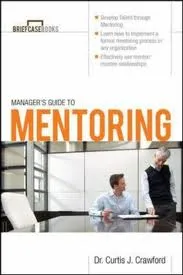[Book Review] Manager's Guide to Mentoring

by Curtis J. Crawford14 chapters; 187 pages
2009 McGraw-Hill (Amazon)
Mentoring, coaching, advising and consulting are important parts of the business and entrepreneurship ecosystem. “Manager's Guide to Mentoring” covers the different types of mentor-mentee relationships, identifies qualities of effective mentors, and makes recommendations for running effective mentoring programmes.
Dr. Curtis J. Crawford is the founder of XCEO, a California-based agency offering professional mentoring, personal leadership development programs, and board leadership development for high-aspiration individuals and organisations. He was previously chairman of the board of ON Semiconductor; CEO of Zilog; CEO of Onix Microsystems; president of the intellectual property division of Lucent Technologies; and marketing VP at IBM. Crawford also served as a special advisor to several startup companies.
The material in the book is straightforward to digest (though at times repetitive), with numerous sidebars and checklists. More specific case studies of actual mentorship in action would have helped, as well as an online companion with additional material.
Mentoring is one of the most useful and important management techniques to drive positive change in organisations, according to Crawford. Mentoring is also much more than supervision or traditional management. “Managers direct, leaders inspire and mentors guide,” he explains.
The author makes important distinctions between coaching and mentoring, which I have summarised in Table 1 below.
Table 1: Differences between Coaches and Mentors
“In today’s globally competitive world, knowledge and its management are key indicators of long-term success,” Crawford observes. Mentoring is an important knowledge transfer strategy in this regard, while also helping high-potential and high-aspiration individuals with new ways of interpreting contexts, revitalisation, energy and excitement.
“Power, in the form of knowledge, is meaningless unless it is earned and shared throughout the organisation,” Crawford advises; hence many companies require experienced employees to take part in mentorship programmes.
“Mentors are not people who only tell you what you want to hear,” Crawford cautions. A good mentor will challenge the mentee on even basic facts, opinions and interpretations. “Effective mentors know that the truth hurts. Great mentors are willing to inflict pain through honest evaluation,” he explains.
Mentors should be regarded as learning partners, confidential sounding boards, non-judgmental counsellors, navigators, networkers, reality checks, champions, facilitators, role models and guides. Key attributes of a good mentor are trust, honesty, integrity, availability, effectiveness, expertise, commitment and passion.
To find the right mentor, mentees need to first of all understand themselves. “It’s important that you allocate substantial time to define your needs, your career objectives and your expectations for yourself,” Crawford advises.
Mentees should also be sincere and committed to the relationship with their mentor, follow the recommended activities, and give constructive feedback.
The author identifies five kinds of mentors, and devotes one chapter to each; I have summarised the arrangements and qualities of such mentor-mentee relationships in Table 2 below.
Table 2: Five Kinds of Mentorship
Formal corporate mentoring is a form of traditional mentorship, the oldest form of mentoring. Interesting trends to watch include the rise of ‘reverse mentoring,’ well exemplified by GE CEO Jack Welch, who in 1999 ordered hundreds of top GE executives to be ‘reverse mentored’ by young employees in how to use the Internet. Gender-based or ethnicity-based mentoring is also on the rise.
In some cases such as peer-mentoring, the arrangements can be in groups rather than just pairs. “Teamwork will make your dream work,” suggests Crawford.
In the long term, a mentee may enter into agreements with a number of mentors at different career and personal stages. Organisations who value people development as a core competency will have a strong focus on mentorship, and combine the full range of mentoring programmes.
Mentorship helps aspiring individuals go from beyond expectation and encouragement to inspiration, which in turn helps them transcend narrow personal interests and invigorate their organisations.
Within organisations, mentoring has helped transmit the organisational culture, enhance career development, and improve the workplace climate. In sum, mentorship should be regarded as an investment and not an expense even during times of economic hardship, the author concludes.
[Follow YourStory's research director Madanmohan Rao]


![[Book Review] Manager's Guide to Mentoring](https://images.yourstory.com/cs/wordpress/2013/02/mentor.jpg?mode=crop&crop=faces&ar=2%3A1&format=auto&w=1920&q=75)




